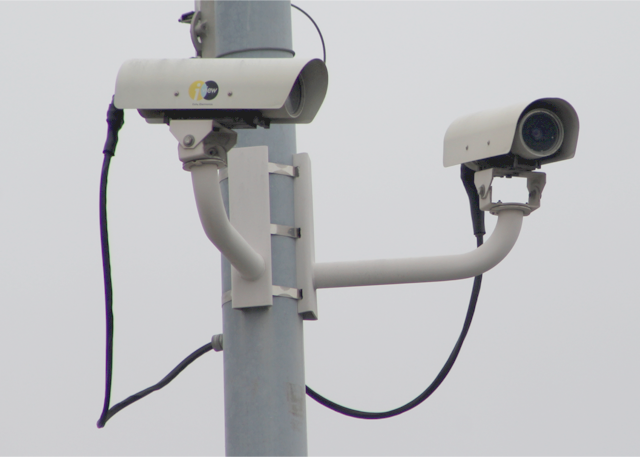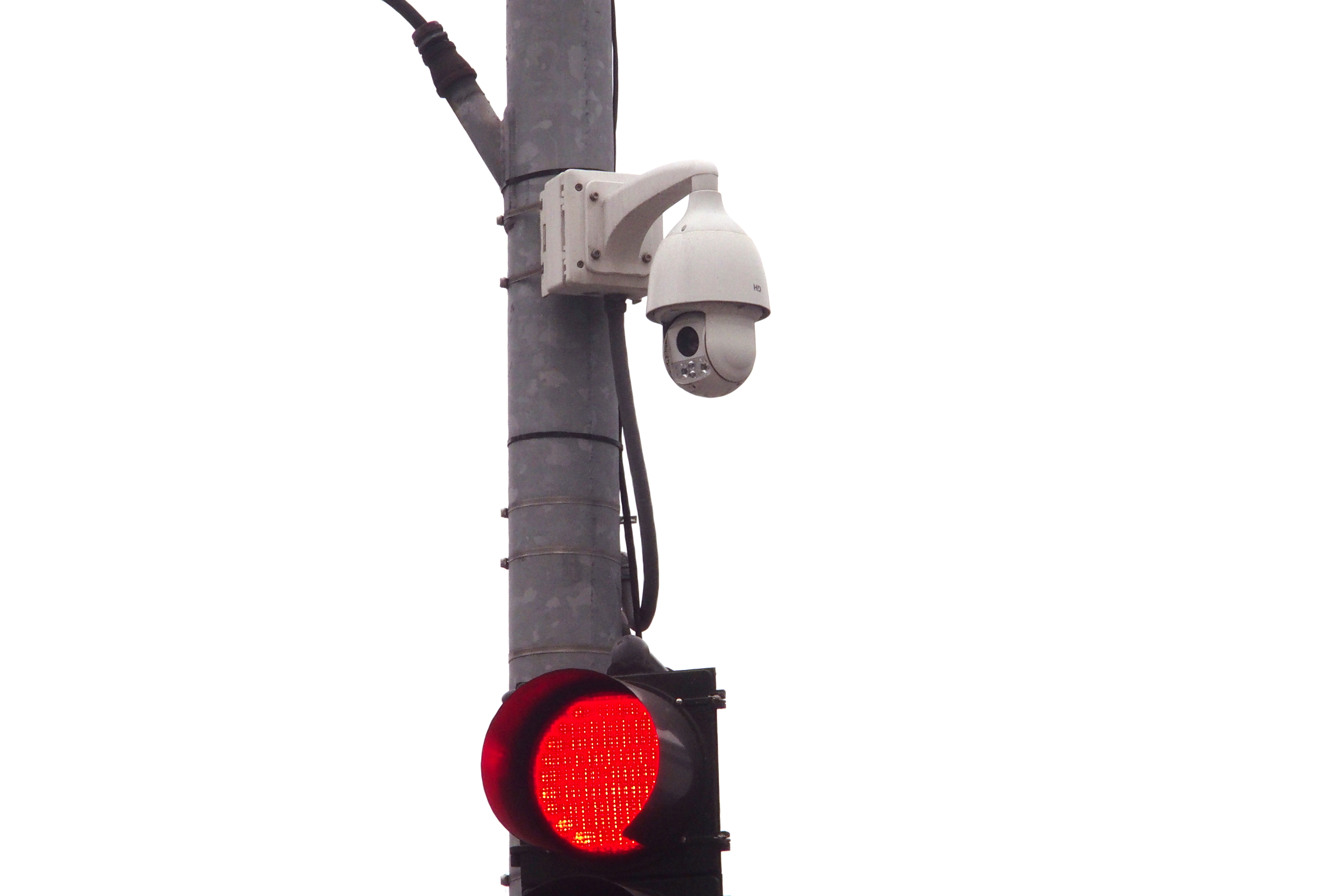https://www.eff.org/pages/surveillance-cameras
Surveillance Cameras
Surveillance cameras are one of the most ubiquitous and recognizable technologies used to watch us as we move about our daily lives. Networks of cameras are installed by government agencies and by local businesses, but the distinction blurs with the development of real-time crime centers that access both public and private video feeds. Camera technology is growing in sophistication: some cameras are capable of 360-degree video or infrared vision. Some models can be equipped with real-time face recognition or license plate recognition software. Since many are also being connected directly to the Internet, the camera networks have also proven easy targets for malicious attackers.
Recognizing the Types of Cameras
Here is a visual guide to some of the types of surveillance cameras you may encounter day-to-day. This is not an exhaustive list, and it’s important to note that some cameras may incorporate multiple features described below.
Bullet cameras
 Photo by Mike Katz-Lacabe (CC BY)
Photo by Mike Katz-Lacabe (CC BY)
Bullet cameras are compact and tube-shaped. The camera, lens, and housing are all packaged within in a cylindrical-style body. These cameras face one direction and sometimes have infrared LEDs for use in low light. Bullet cameras are used both indoors and outdoors.
Dome cameras
 Dome cameras inside the San Francisco Museum of Modern Art and outside a storefront in Union Square
Dome cameras inside the San Francisco Museum of Modern Art and outside a storefront in Union Square
Dome cameras are typically used for indoor surveillance, and are often mounted on ceilings. The camera’s dome shape is designed to make it difficult to tell which direction the camera is facing. Dome cameras come with many optional features. Some have infrared light for night vision, some have tamper-resistant features, and some have varifocal lenses, allowing operators to adjust the focal distance of the camera lens.
PTZ (Pan Tilt Zoom) cameras

Most surveillance cameras are fixed cameras—they face just one direction. PTZ cameras are remotely controlled, and allow the operator to pan (move left or right), tilt up and or down, or zoom closer or farther away in order to follow people as they move. This lets operators zoom in on specific areas or track specific movements. The cameras can also run patterns or turn to a preset position.
Mobile Surveillance Towers/Poles
 A ‘Mobile Utility Surveillance Tower’ at San Diego Comic-Con and a mobile surveillance pole in New Orlean’s French Quarter
A ‘Mobile Utility Surveillance Tower’ at San Diego Comic-Con and a mobile surveillance pole in New Orlean’s French Quarter
Not all surveillance cameras are static. Law enforcement agencies often acquire mobile surveillance units, such as manned towers that can be raised 25-feet in the air and unmanned trailers that can extend a pole with PTZ cameras in all directions. These systems are often used to establish situational awareness at public events and in high-traffic commercial areas.
Thermal cameras
 FLIR dual-sensor thermal camera at the White House with pan-tilt-zoom capabilities
FLIR dual-sensor thermal camera at the White House with pan-tilt-zoom capabilities
Most video captures images in the natural light or infrared spectrums. Thermal cameras can also capture video of a person’s movements based on body temperature. These cameras are not always distinguishable from conventional security cameras, however the brand name FLIR is often a tell-tale sign that the camera is capable of thermal imaging.
Automated license plate readers
 Photo by Mike Katz-Lacabe (CC BY)
Photo by Mike Katz-Lacabe (CC BY)
Automated license plate readers (ALPRs) are computer-controlled camera systems that capture license plate numbers, as well as photographs of the vehicles and sometimes drivers and passengers. ALPR cameras include fixed cameras, often mounted on traffic lights, telephone poles, or other locations. They also include mobile cameras, which are typically attached to police patrol cars. Some agencies have mobile ALPR trailers that they can move to targeted locations.
Read more about automated license plate readers.
Data Sharing
Cameras often broadcast footage over the Internet, allowing operators to monitor security camera feeds remotely. In some cases, surveillance systems are paid for and operated by the cities themselves. But in other cases, residents and businesses share surveillance camera footage with police officers.
In 2019, EFF obtained a dataset of surveillance cameras maintained by the San Francisco District Attorney’s Office. Click here to launch in a new window or read the blog post.
Many law enforcement agencies have begun private security camera registration programs (sometimes called “SafeCam”), whereby residents and business owners can provide basic information about the cameras they own and where they are located. Then, when a crime is reported, police may search their database of cameras and contact the owner directly to obtain the footage. Some examples of this program include the Philadelphia Police Department (PA), Fultondale Police Department (AL), and the San Francisco District Attorney’s Office (CA). The Phoenix Police Department refers to its program as the “Virtual Block Watch.”
In San Francisco, the Union Square Business Improvement District launched an outdoor security camera program in 2012 with just six privately owned cameras. Now it is a surveillance network of 350 cameras, all of which share footage with the police. According to news reports, grant money pays for around 90% of the cost for the cameras in Union Square, and business owners who wish to participate pay the remainder.
Real-Time Crime Centers
 Fresno Police Department’s Real-time Crime Center. Source: Fresno PD Annual Report 2015
Fresno Police Department’s Real-time Crime Center. Source: Fresno PD Annual Report 2015
Several cities feed video surveillance into monitoring headquarters, often referred to as “domain awareness centers” or “real-time crime centers.” Some hope to expand the footage they collect through their own surveillance cameras by also tapping into footage taken by private individuals and businesses.
In New Orleans, for example, video feeds from more than 300 street-facing surveillance cameras are fed into a $5 million high-tech monitoring center created in 2017. The footage is monitored 24/7. The mayor’s office has continued installing additional cameras, and has expressed interest in integrating private cameras with the monitoring center. The city’s automated license plate readers also feed into the RTC center.
Nearly 100 surveillance cameras—24 PTZ cameras, 17 dome cameras, and 54 license recognition cameras are being installed on 64 power poles in Birmingham, Alabama. The cameras will be monitored by the Jefferson County Metro Area Crime Center. The license plate recognition camera data will be uploaded to the FBI’s Criminal Justice Information Services, and the city will obtain the content from the FBI’s portal. Although aproposed ordinance requiring all establishments with liquor licenses to install cameras that feed into the monitoring center was abandoned in the face of opposition, several bars accused of violating liquor laws have entered consent decrees with the city’s Alcoholic Beverage Control board, requiring them to do just that.
The San Diego Police Department hoped to gain access to footage from public and private cameras in real time as part of the “Operation Secure San Diego” surveillance program. As of 2014, the program was riddled with software compatibility problems, and officers had difficulty viewing footage in real time because the department’s police cruisers did not have a 4G connection. The city has since adopted a new partnership with General Electric in which street lights are equipped with cameras and microphones.
Emerging Issues
On its face, video surveillance technology is already pervasive. But beyond the privacy concerns of law enforcement’s widespread access to historical and real-time video footage lies the threat of it being accessed by malicious hackers. Since camera networks are typically connected directly to the Internet, they pose easy targetsfor these bad actors.
For example, two-thirds of D.C.’s police surveillance cameras were attacked by hackers days before the 2017 presidential inauguration as part of a ransomware attack, causing more than 100 of the cameras to go dark.
In 2015, EFF learned that more than a hundred ALPR cameras were exposed online, often with totally open Web pages accessible by anyone with a browser. In some cases, anyone could open a browser window and view a camera’s live video stream and witness the plate captures in real time. We were able to track the cameras to their sources in five different instances. Similar ALPR vulnerabilities were discovered in Boston by DigBoston and the Boston Institute for Nonprofit Journalism.
When combined with face recognition, surveillance camera networks raise additional privacy and civil rights concerns—particularly because face recognition data is prone to error. Amazon’s face recognition tool,Rekognition, is among the real-time video face recognition products currently being piloted by police departments around the country, as well as the FBI.
Read more about face recognition technology.
Face recognition, however, is only one form of automated video analysis being deployed with surveillance cameras. IBM, for example, offers a sophisticated analytical software that it claims can identify anomalies in public spaces (such as abandoned packages) and track individuals based on their clothing, glasses, or facial hair. Amazon peddles a machine-learning product dubbed “DeepLens,” a deep-learning enabled video camera for developers that can be integrated with another of its machine-learning products, “SageMaker,” to increase the inter-operability of various data analytics programs from the videofeeds.
In short, the proliferation of surveillance cameras has rapidly reduced our ability to maintain anonymity in public spaces; and the advent of automated face recognition and other tracking technologies only accelerate this threat to privacy.

